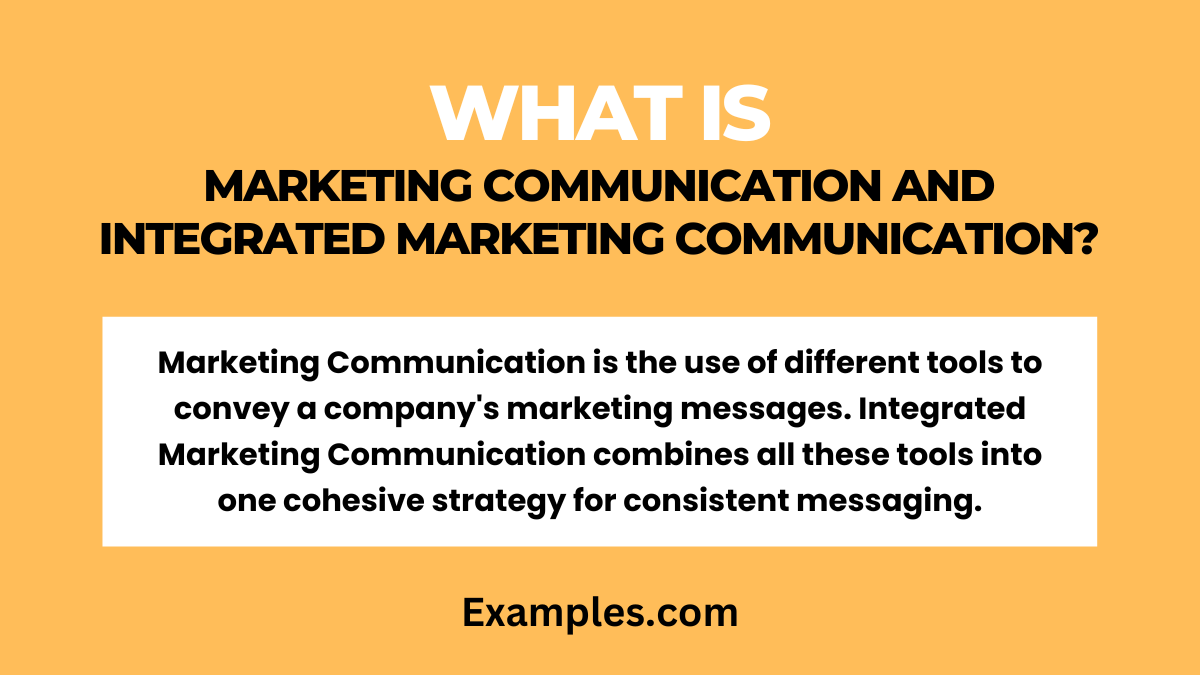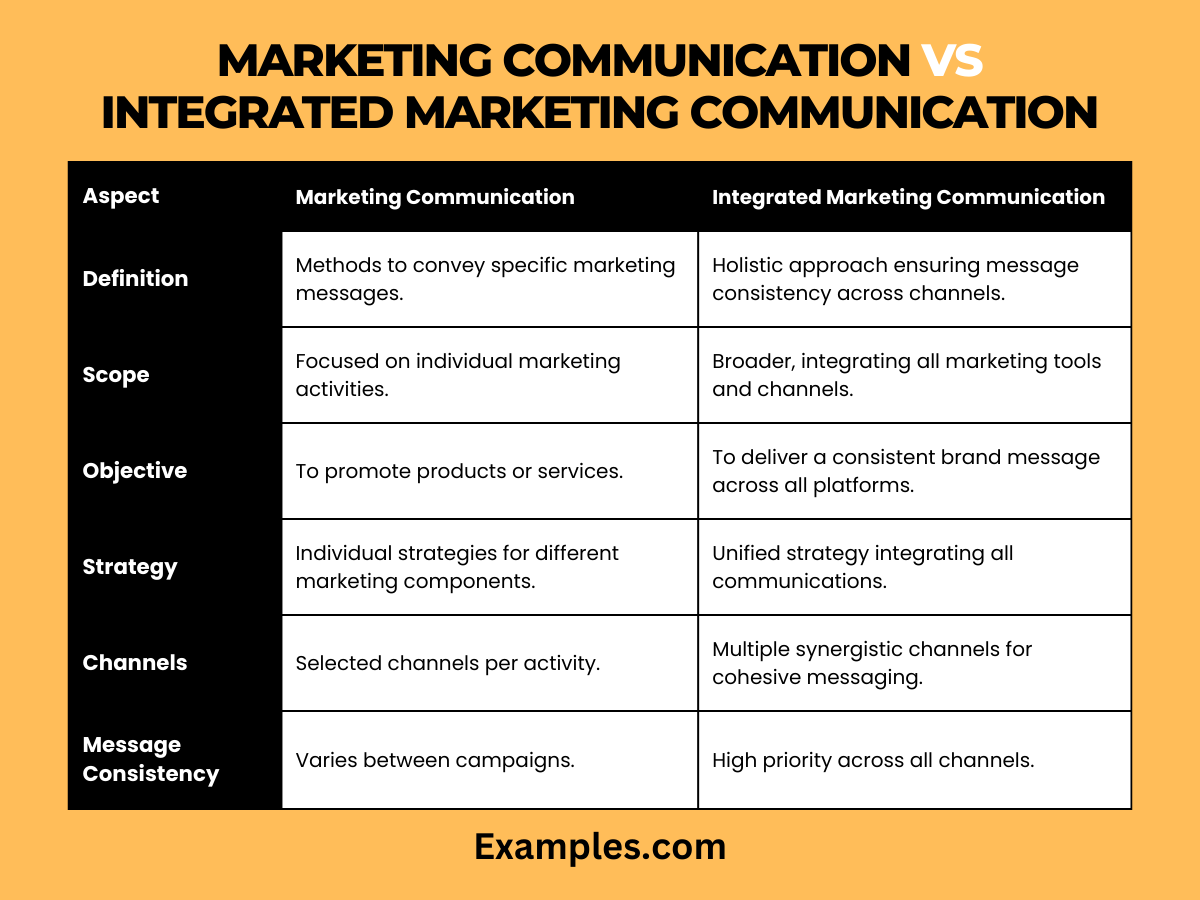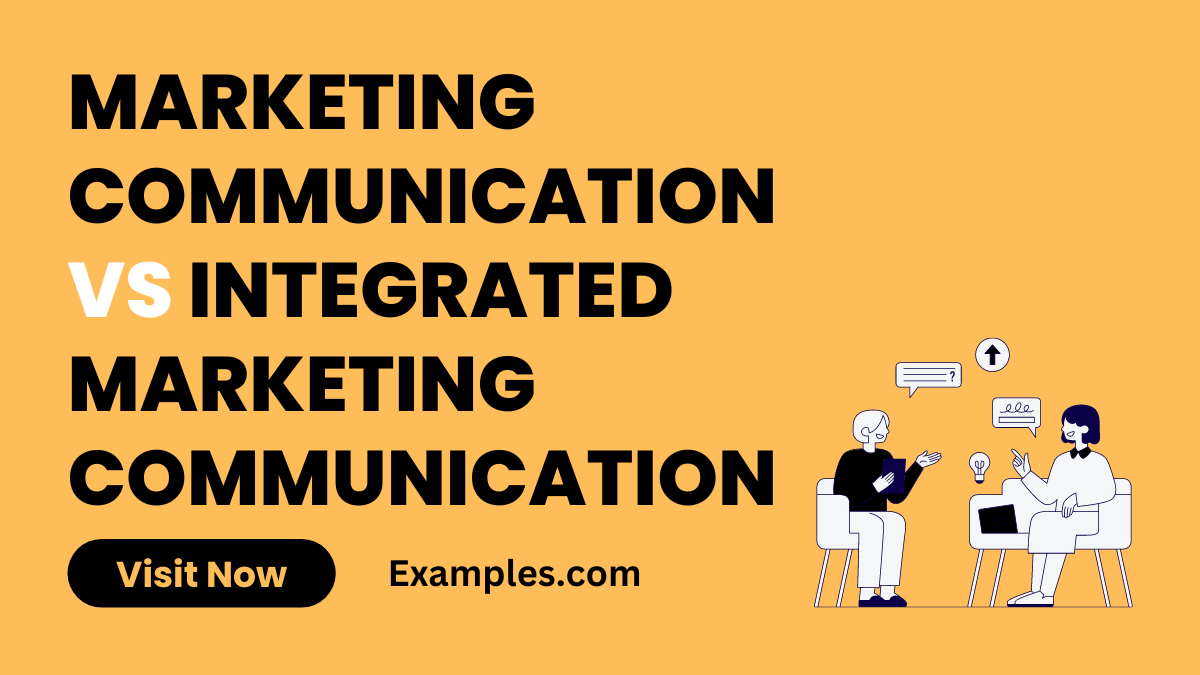Marketing Communication vs Integrated Marketing Communication – 19+ Examples
Delve into the essential differences between Marketing Communication and Integrated Marketing Communication with this comprehensive guide. Filled with practical insights and diverse Marketing Communication Examples, it clearly distinguishes these two pivotal marketing strategies. This guide is tailored for businesses, marketers, and communication professionals seeking to understand the nuances of each approach and how they can be applied to enhance marketing effectiveness and brand coherence.
What is Marketing Communication and Integrated Marketing Communication?

Marketing Communication (MarCom) refers to the various methods and tools that businesses use to convey their marketing messages to their target audience. This can include advertising, public relations, direct marketing, and more. It’s about how companies communicate with customers to promote their products or services.
Integrated Marketing Communication (IMC) is a step further. It combines all aspects of marketing communication such as advertising, sales promotion, public relations, and direct marketing into a cohesive whole. This approach ensures consistency in all marketing efforts, providing a unified message across all channels and touchpoints.
Difference between Marketing Communication and Integrated Marketing Communication
The distinction between Marketing Communication and Integrated Marketing Communication (IMC) is crucial in the realm of marketing strategy. To clarify these concepts, here’s a comparative table outlining the key differences:

| Aspect | Marketing Communication | Integrated Marketing Communication |
|---|---|---|
| Definition | Marketing Communication refers to the various methods and tactics used to convey a marketing message to the public. | Integrated Marketing Communication is a holistic approach to ensure consistency in message across all channels. |
| Scope | Focuses on specific marketing activities such as advertising, sales promotions, and public relations. | Encompasses a broader range of communication elements, integrating all marketing tools and channels. |
| Objective | Primarily aimed at promoting a product or service. | Aims to deliver a consistent message across all marketing platforms to reinforce the brand identity. |
| Strategy | Often involves isolated or individual strategies for different components of marketing. | Involves a coordinated and unified strategy that integrates all marketing communications to deliver a cohesive message. |
| Communication Channels | May use selected channels based on the specific marketing activity. | Utilizes a combination of multiple channels like social media, traditional media, direct marketing, etc., in a synergistic manner. |
| Message Consistency | Message consistency is not always a priority; different campaigns may have varied messages. | High priority on maintaining message consistency across all marketing and communication channels. |
| Customer Engagement | Engagement can be limited to specific campaigns or promotions. | Focuses on building long-term customer relationships through consistent and continuous engagement across all touchpoints. |
| Measurability and Tracking | Individual campaign success is often measured in isolation. | Emphasizes integrated tracking and analysis across all communication efforts to evaluate overall impact on brand perception and sales. |
| Flexibility and Adaptation | Can be more flexible, with changes made in specific areas without affecting the whole marketing strategy. | Requires a more holistic approach, where changes in one area necessitate adjustments across all integrated strategies. |
| Budget Allocation | Budget is often allocated per campaign or communication channel. | Budget is allocated to unified communication efforts, considering the integration of various channels and tools. |
10 Examples of Marketing Communication
Marketing Communication encompasses various techniques used to convey messages to the target audience. Here are ten types of marketing communication:
- Television Advertising: Utilizes visual and auditory elements to promote products or services on TV channels.
- Print Media: Involves advertising through newspapers, magazines, flyers, and brochures.
- Direct Mail Campaigns: Sending promotional materials directly to potential customers through postal mail.
- Outdoor Advertising: Includes billboards, transit advertisements, and posters in public spaces.
- Radio Broadcasting: Utilizes audio advertisements on radio stations.
- Email Marketing: Sending promotional emails to a list of subscribers or potential customers.
- Social Media Campaigns: Using platforms like Facebook, Twitter, and Instagram for promotions.
- Event Sponsorships: Sponsoring events to increase brand visibility and connect with audiences.
- Webinars and Online Workshops: Hosting online sessions to educate and engage with customers.
- Influencer Partnerships: Collaborating with influencers for product promotion and brand awareness.
10 Examples of Integrated Marketing Communication
Integrated Marketing Communication (IMC) is a strategy that integrates various communication methods to provide a consistent message across all platforms. Here are ten types of integrated marketing communication:
- Cross-Platform Advertising Campaigns: Coordinating advertising efforts across TV, digital, and print media.
- Branded Content Across Channels: Creating and sharing content that aligns with the brand’s identity on different media outlets.
- Social Media and Email Marketing Synergy: Combining social media advertising with follow-up email marketing.
- Consistent Branding Across All Materials: Ensuring uniform branding in advertising, packaging, and digital presence.
- Website and Offline Experience Integration: Aligning the online presence with the physical customer experience.
- Public Relations and Advertising Coordination: Synchronizing PR activities with advertising campaigns.
- Customer Service and Marketing Alignment: Informing customer service teams about ongoing marketing campaigns.
- In-Store Promotions and Online Advertising: Linking online advertising with physical store promotions.
- International Market Messaging Consistency: Adapting marketing campaigns for different markets while maintaining the core brand message.
- Omnichannel Retail Strategy: Creating a seamless shopping experience across various shopping channels.
Comparison Between Marketing Communication and Integrated Marketing Communication
When delving into the realms of Marketing Communication (MarCom) and Integrated Marketing Communication (IMC), it’s essential to understand their differences and how each plays a unique role in the marketing landscape. This comprehensive guide offers a detailed comparison, shedding light on the distinct features and approaches of each strategy.
- Scope and Integration: MarCom focuses on specific marketing communication tools like advertising or PR. In contrast, IMC integrates all communication tools to ensure a consistent message.
- Consistency of Message: While MarCom might use different messages across various platforms, IMC ensures a uniform message, enhancing brand consistency.
- Strategic Approach: MarCom often operates within individual marketing channels. IMC, however, adopts a holistic approach, coordinating all channels for a unified strategy.
- Targeting and Engagement: MarCom may target specific segments through tailored channels. IMC engages the entire market spectrum, creating a comprehensive brand experience.
- Measurement and Effectiveness: IMC offers a more measurable impact due to its integrated nature, while MarCom’s impact might be segmented by channels.
Relationship Between Marketing Communication and Integrated Marketing Communication
The relationship between Marketing Communication and Integrated Marketing Communication is intertwined and crucial for a comprehensive understanding of modern marketing practices. This section explores how these two facets of communication work together and complement each other in the marketing world.
- Building Blocks: MarCom serves as the foundation for IMC. The various tools and channels of MarCom are integrated in IMC for cohesive messaging.
- Strategic Alignment: While MarCom strategies can be developed independently, IMC aligns these strategies towards a common goal, ensuring all marketing efforts speak in one voice.
- Enhanced Effectiveness: MarCom’s effectiveness is amplified when integrated under the IMC umbrella. Consistent messaging across channels, a hallmark of IMC, reinforces the brand’s message.
- Adaptation and Evolution: The evolution of MarCom into IMC reflects the changing marketing landscape, emphasizing the need for a more holistic and unified approach in today’s digital age.
- Complementing Objectives: While MarCom focuses on channel-specific objectives, IMC looks at the bigger picture, ensuring all communications contribute to the overarching brand strategy.



